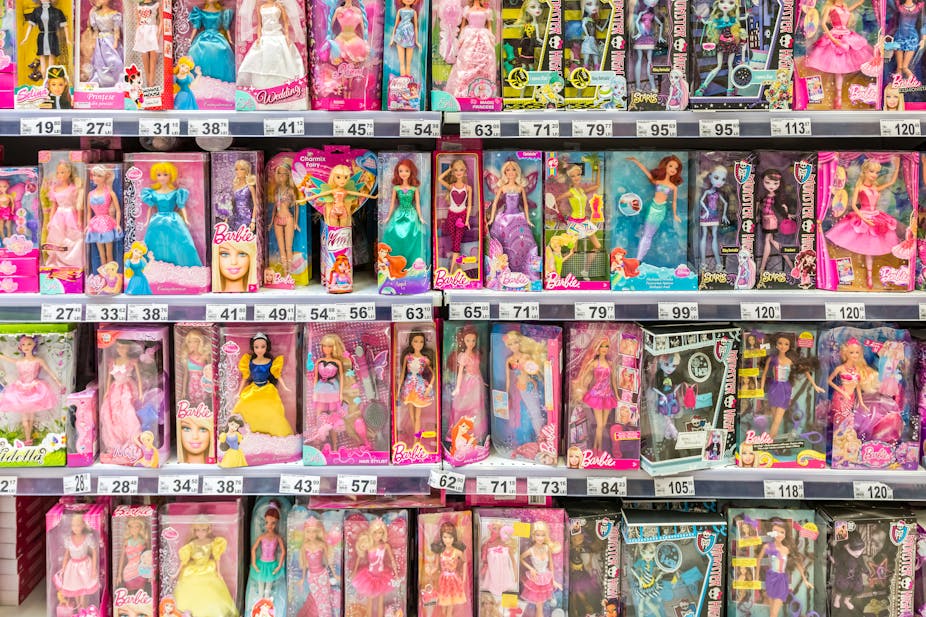Love her or hate her Barbie is a cultural artefact, if not an icon. She has been critiqued for her influence on women’s body image and lauded by others as an embodiment of the American Dream. But putting aside the arguments over her unlikely size and possible influence on what girls think about themselves, Barbie has been an incredibly successful brand for the American toy company Mattel and it has just announced 33 new models – curvy, petite and tall Barbies, in a range of skin tones, hair and eye colours.
At 57-years-old Barbie has had as good a run as any well-known brand and much better than most toys. One of the reasons for this success seems to have been an ability to ride out the so-called product life cycle, which suggests that most products and brands move through introduction and growth to maturity and decline.
Mattel’s successful formula with Barbie is that it has never allowed her to mature. The company has kept up with the latest fashions and has also responded to criticisms and concerns in an effort to maintain Barbie’s popularity. Mattel has also made sure that success does not rely on one Barbie doll alone, but has continued to innovate with new and different types of dolls alongside its flagship blonde Barbie.
Changing with the times
Barbie herself has actually changed quite a bit. In the 1980s she was into aerobics and had brightly coloured eye shadow. When criticised for lacking ambition she took on careers to suit different levels of aspiration – from McDonald’s waitress to veterinarian. Then when disparaged for a lack of diversity, Mattel introduced the first black Barbie in 1981. Her continued success saw Barbie outpace look-a-like rivals from the market such as Maxie Fashion Dolls from Mattel’s main competitor Hasbro. It wasn’t until 1999 that Barbie ended the year down on sales, which the chief executive at the time attributed to an industry-wide decline in orders from retailers not wanting to hold excess inventory.

But other toy manufacturers were not going to stand still and in the last few years Barbie has faced competition from a whole host of new dolls vying for girls’ and their parents’ favour. In 2001 toy maker MGA Entertainment introduced the Bratz dolls, highly stylised made-up dolls that some suggest make Barbie look positively wholesome. In contrast, the Lottie Doll made by British company Arklu is unmistakeably a little girl with accessories built around decidedly middle class activities such as pony riding and ballet dancing.
And for those parents who want an alternative aspirational teenage doll there is now Lammily whose proportions are based on an average 19-year-old woman, as measured by the American Centres for Disease Control. She is the antithesis to Barbie and comes with stick on additions that include freckles, glasses, bruises and dirt.
But Mattel has managed its portfolio well. In 2013 when sales of Barbie were declining its American Girl line was the most successful doll selling in the US. American Girl was the inspiration of a teacher who wanted to portray the plurality of American life – not only with dolls of different ethnicities but also dolls in wheelchairs and wearing spectacles; each comes with a book that deals with topics including poverty and race. It proved lucrative, with the average American Doll owner spending more than US$300 a doll on accessories.
That Mattel experiments only so far with Barbie and introduces new products alongside her is an important element to its success and allows the company to take greater risks with new products and develop the flagship doll at a more evolutionary pace. For 2016 they have Super-Hero Girls, replicas of comic book heroes such as Wonder Woman, which will also have an animated TV show and Lego tie-in.
Keeping up with the competition
The last year, however, hasn’t been plain sailing for Mattel. Sales of Barbie have continued to fall as Lego rose to become the biggest toy company in the world in 2014, helped by its toys for girls range, Lego Friends. But perhaps the biggest blow was rival Hasbro winning the Disney Princess franchise from Mattel at the moment when Frozen’s Elsa took over from Barbie as the most popular girls toy.
So the new body shapes that are being introduced may have come at just the right moment for Mattel. Not least, she will reflect the new American beauty aesthetic of stars such as Kim Kardashian West, Beyoncé and Christina Hendricks.
The last word should perhaps be given to Richard Dickson, president and chief operating officer of Mattel, who said:
Barbie reflects the world girls see around them. Her ability to evolve and grow with the times, while staying true to her spirit, is central to why Barbie is the number one fashion doll in the world.
Above all it is Mattel’s ability to see how times change that will allow Barbie to cling on for a few more years yet.

